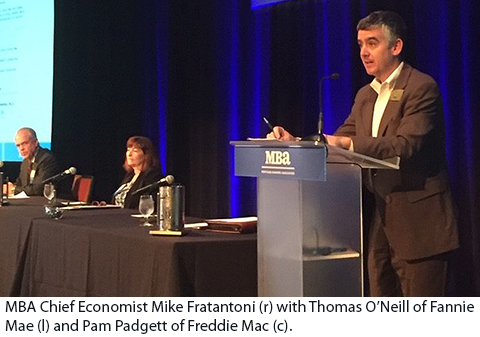
GSEs Seeing Fewer Defects, Better QC Results
CHICAGO–Representatives of Fannie Mae and Freddie Mac here at the Mortgage Bankers Association’s Risk Management, QA and Fraud Prevention Forum said quality of loans submitted to them show better quality control processes and fewer defects, but cautioned that the defects the do appear show a greater degree of sophistication.
 Thomas O’Neill, Credit Risk Manager of Loan Quality with Fannie Mae, said in recent years the defect rates for loans submitted to Fannie Mae have been “vastly improved.” He said those rates remains favorable, despite loosening of credit over the past year.
Thomas O’Neill, Credit Risk Manager of Loan Quality with Fannie Mae, said in recent years the defect rates for loans submitted to Fannie Mae have been “vastly improved.” He said those rates remains favorable, despite loosening of credit over the past year.
Pam Padgett, Vice President of Quality Control with Freddie Mac, McLean, Va., said her company sees similar results, noting substantive declines in defects. But she noted where defects occur, persistent patterns remain, particularly in which insufficient assets are being included and missing income statements, as well as insufficient evidence of funds to close.
“We strictly enforce our documentation requirements on these loans in particular,” Padgett said. “We are trying to reduce catastrophic events with these loans.”
O’Neill noted loans submitted by self-employed applications tended to have the most incorrect information, primarily with income calculations. “This isn’t surprising,” he said. What is surprising, he said, is a shift in defects reported in both liabilities (previously second) and assets (previously first). “A lot of borrowers go all in-they buy the new house and they decide to buy a new car, too, and sometimes the car purchase doesn’t get reported,” he said. “But we find it.”
Padgett said the most persistent issues present in determining stable income. “We have a lot of borrowers new to their jobs, and many of them start jobs at the beginning of the year,” she said. “This makes it difficult to find a tax trail. Also, some lenders are ‘averaging’ income levels, which are red flags that point to fraud.”
Padgett noted while volume of red flags continue to fall, the sophistication of fraud is growing. “We have looked at submitted bank statements that look fine at first, but upon further examination, become apparent,” she said. “Just as disturbing, we are seeing an increase in the number of employers who are covering up for their employees.”
This speaks to two issues, Padgett said: re-evaluation and training. “It’s vitally important that we review loans; and it’s incumbent among lenders to provide training to reduce instances of fraud,” she said.
Padgett cautioned, however, that automation is not fraud-proof. “It’s critical to fully test and confirm the data, from source to output and the security and the path,” she said. “As we evolved to more automation, we are still at risk for error and we have to ensure that we anticipate and closed gaps in the processes. And we need to know who we are doing business with, have strong QC controls and ensure we have a well-trained staff.”
Padgett added the industry has to look beyond mortgage fraud and look more closely at cybersecurity in general–“vendors, partners, suppliers, employees and customers,” she said. “The shift to the digital world is a journey, not a destination.”
Last month, Fannie Mae updated its Selling Guide clarifying quality control issues, the first update of that section in more than four years; O’Neill said Fannie Mae “got a little more prescriptive” in its clarifications. “We are fully committed to the path of the digital mortgage to create a better experience for the borrower and the lender,” he said. “We have worked with a number of lenders with our Day 1 Certainty program.”
The program provides “freedom” from paper-based processes with validation of income, assets and employment through third-party data vendors. “We understand that some lenders aren’t there yet,” O’Neill said. “But we’ve found that those lenders that have used Day 1 Certainty are seeing improved processes, and we’re seeing submissions through the program with fewer errors and less risks to reps and warranties.”
